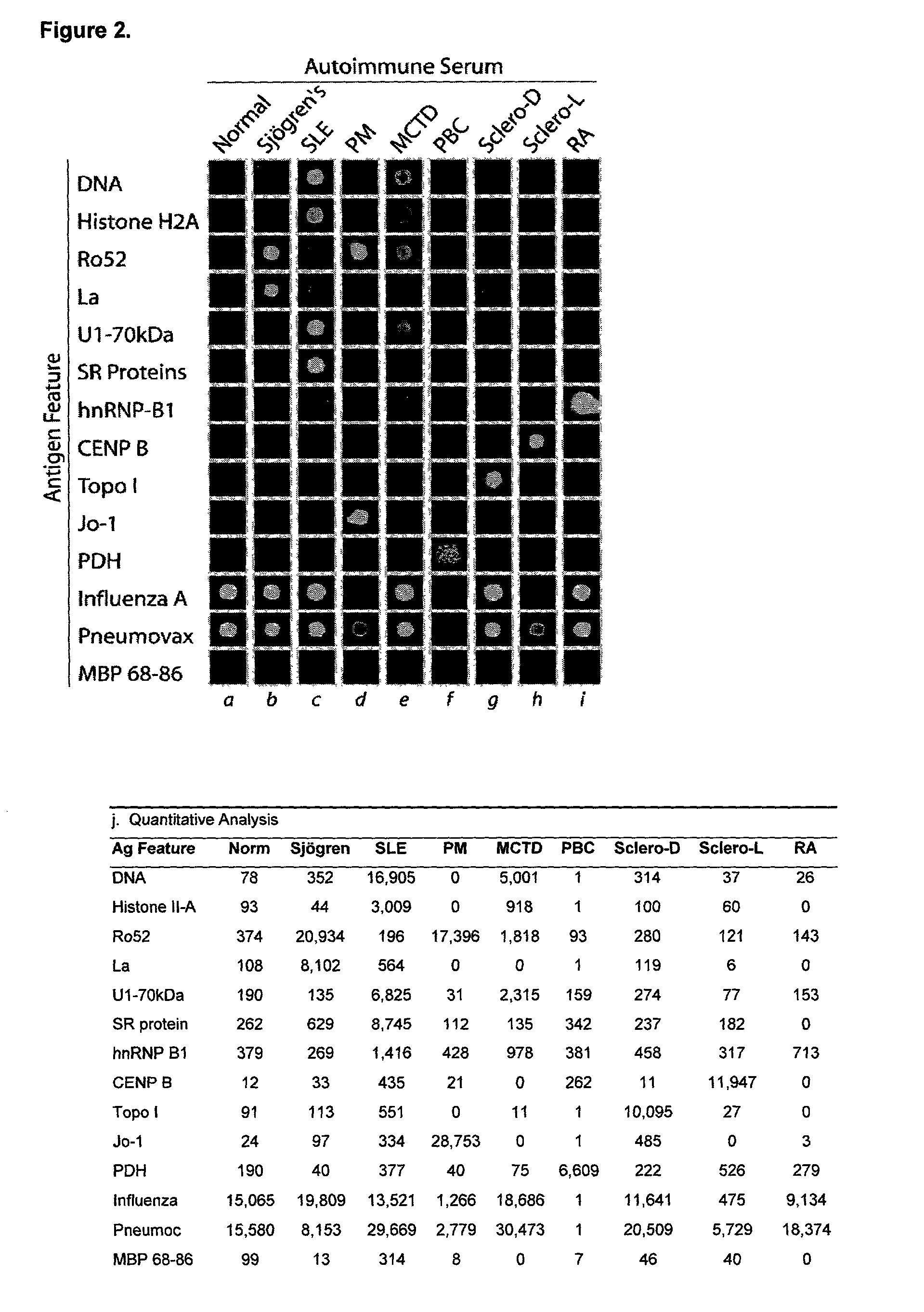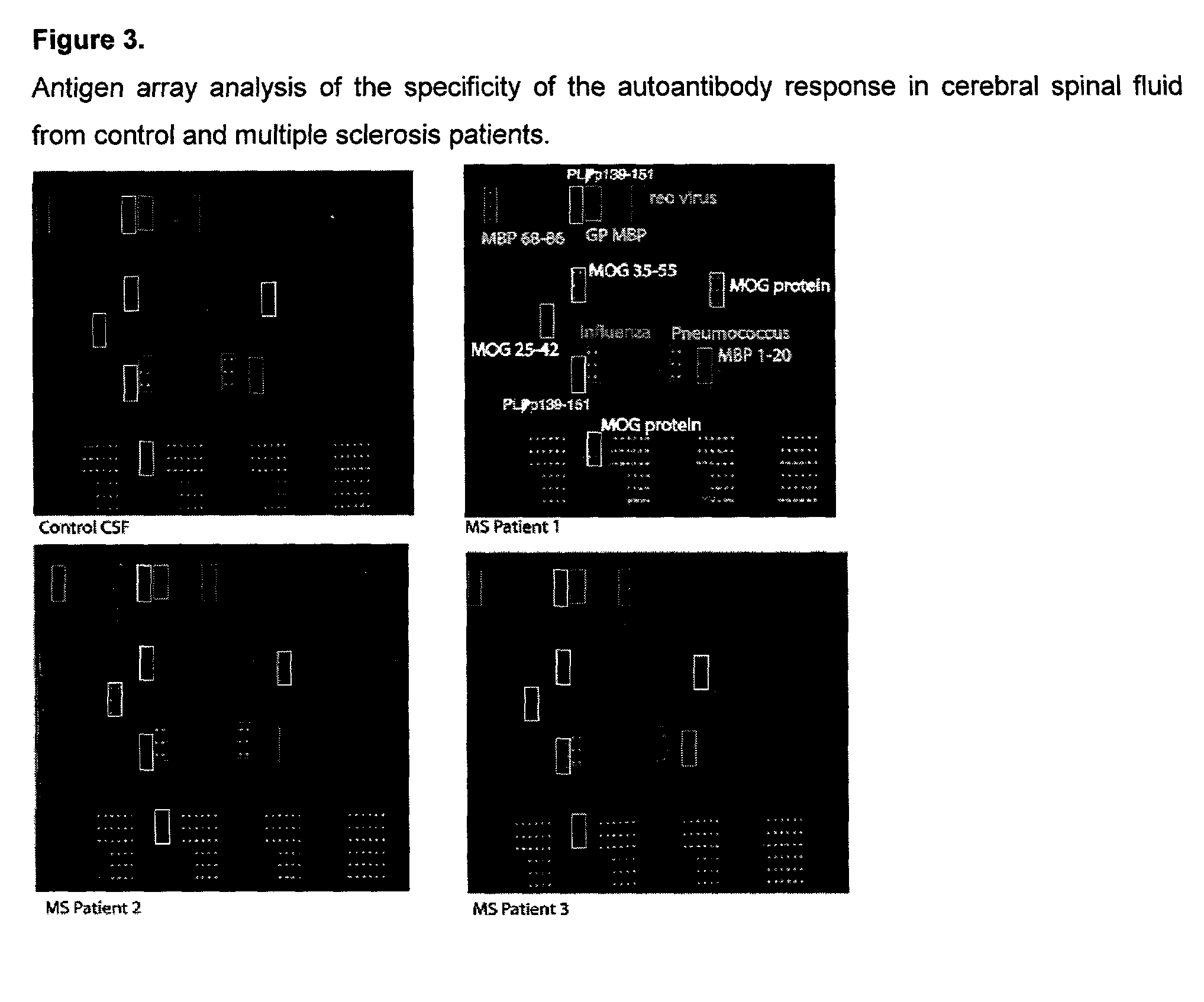Therapeutic and diagnostic uses of antibody specificity profiles
a technology of antibody specificity and therapeutic use, which is applied in the field of therapeutic and diagnostic use of antibody specificity profiles, can solve the problems of astonishing complexity of the immune system, difficult diagnosis and therapy, and diversity
- Summary
- Abstract
- Description
- Claims
- Application Information
AI Technical Summary
Benefits of technology
Problems solved by technology
Method used
Image
Examples
example 1
Antigen Array Characterization of the Specificity of the Autoantibody Response in EAE in Rats and Mice
[0117]To determine the autoantibody specificity profile in the serum of animals with EAE, an assay was performed testing the binding of serum antibodies to a protein microarray.
[0118]Antigen arrays were generated by spotting the immunodominant myelin peptide epitopes and purified native myelin basic protein, as listed in Table 1. FIGS. 1A-D are scanned imaged of arrays probed with serum from a normal control rat (A) and 3 Lewis rats induced to develop EAE with different myelin protein peptides in complete Freund's adjuvant (B-D), followed by Cy-3 labeled anti-rat Ig secondary antibody.
[0119]Quantitative computer analysis of the scanned images is presented in Table 1. The reported numbers represent the ratio of the fluorescence intensity of antigens recognized by serum derived from animals with EAE relative to control serum adjusting for background levels such that ratios greater or ...
example 2
Determination of the Patient Antibody Specificity Profile in Autoimmune Rheumatic Diseases
[0121]Autoantigen arrays identify autoantibody profiles characteristic of eight distinct human autoimmune rheumatic diseases. Representative examples of autoantigen array analysis of over 50 highly-characterized autoimmune serum samples are presented (FIG. 2).
[0122]Ordered autoantigen arrays were generated by spotting 192 distinct putative autoantigens in quadruplicate sets using a robotic microarrayer to create a 1152-feature rheumatic disease autoantigen array. Spotted antigens include: 36 recombinant or purified proteins including Ro52, La, histidyl-tRNA synthetase (Jo-1), SR proteins, histone H2A (H2A), Sm-B / B′, the 70 kDa and C component of the U1 small nuclear ribonucleoprotein complex (U1-70 kDa, U1snRNP-C), Sm-B / B′, hnRNP-B1, Sm / RNP complex, topoisomerase I (topo I), centromere protein B (CENP B), and pyruvate dehydrogenase (PDH); six nucleic acid-based putative antigens including sever...
example 3
Determination of the Autoantibody Specificity Profile from the Cerebral Spinal Fluid from Human Multiple Sclerosis Patients
[0125]Antigen arrays containing myelin proteins and peptides were used to characterize the specificity of the autoantibody response in cerebral spinal fluid samples derived from human patients with multiple sclerosis (FIG. 3). The arrays in FIG. 3 demonstrate detection of cerebral spinal fluid autoantibodies specific for whole myelin basic protein (MBP), MBP peptide 1-20 (corresponding to amino acids 1-20 of MBP), MBP peptide 68-86, whole myelin oligodendrocyte protein (MOG), MOG peptide 35-55, and proteolipid protein (PLP) peptide 139-151. As in Example 2, such information can be used for diagnosis and to develop, monitor and select specific therapy.
[0126]2400-spot ‘myelin proteome’ arrays were produced by spotting these putative myelin antigens using a robotic microarrayer, probed with cerebral spinal fluid followed by Cy-3-labeled anti-human Ig secondary anti...
PUM
| Property | Measurement | Unit |
|---|---|---|
| Mass | aaaaa | aaaaa |
| Time | aaaaa | aaaaa |
| Time | aaaaa | aaaaa |
Abstract
Description
Claims
Application Information
 Login to View More
Login to View More - R&D
- Intellectual Property
- Life Sciences
- Materials
- Tech Scout
- Unparalleled Data Quality
- Higher Quality Content
- 60% Fewer Hallucinations
Browse by: Latest US Patents, China's latest patents, Technical Efficacy Thesaurus, Application Domain, Technology Topic, Popular Technical Reports.
© 2025 PatSnap. All rights reserved.Legal|Privacy policy|Modern Slavery Act Transparency Statement|Sitemap|About US| Contact US: help@patsnap.com



